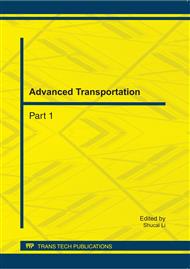[1]
Bishop R. A Survey of Intelligent Vehicle Application Worldwide. Proceeding of the IEEE Intelligent Vehicles Symposium 2000. Dearborn: USA, 2000, 25~30
Google Scholar
[2]
MA Rui, KONG Xingwei, Current Status and the Development Trend of the GNSS, MODERN DEFENCE TECHNOLOGY: 73~74
Google Scholar
[3]
Dong Wenli. Kalman filtering algorithms of vehicle navigation positioning. Master degree theses of Zhengzhou University: (2007)
Google Scholar
[4]
He Zishu, Xia Wei, etc. Modern digital signal processing and application. Tsinghua University press. 2009.5:244~281
Google Scholar
[5]
Okutani, Stephamedes YJ. Dynamic prediction of traffic volume through Kalman filtering theory [J]. Transportation Research B.1984, 18B (1):1~11.
DOI: 10.1016/0191-2615(84)90002-x
Google Scholar
[6]
Qin Yongyuan, Zhang Hongyue, Wang Shuhua. Kalman filter and combined navigation principles [M].Northwestern polytechnical university press,1998.
Google Scholar
[7]
E.Abbott,D.Powell.Land Vehicle Navigation Using GPS[J].Proceedings of the IEEE,87(1):145~162,1999.
Google Scholar
[8]
Zhang Santong, Chen Fengyu, Wei Chenguan..New methods of vehicle combined navigation [J].Journal of Beijing technology university,19(1):44~49。1999.
Google Scholar
[9]
Li Qinghua. Centralized and distributed multi-sensor information fusion filter design based on the theory of H∞ filtering (Ph.D. Thesis)
Google Scholar
[10]
He You, Peng Yingyu. State estimation of two hybrid multi-sensor information fusion [J]. Electronic science journal, 1999, 21(5): 698-701.
Google Scholar
[11]
Zhou Ye, Dai Guanzhong, Wang Lixin. Synthetic algorithm estimate of linear discrete-time system [J]. Control and decision, 1989, 4(6): 1-6
Google Scholar
[12]
Yang Chunling, Liu Guosui, Yu Yinglin. Research of multisensor target tracking fusion algorithm of the nonlinear system [J]. Journal of aviation, 2000, 21(6): 512-515
Google Scholar
[13]
Wang Hesheng, Wu Huangsheng, Chen Shangwei H∞ controller design for GPS receiver tracking loop Proc. Int. Tech. Meet. Satell. Div. Inst. Navig. ION GNSS2004:510-522.
Google Scholar
[14]
Ge L, Han S and Rizos C. Multipath mitigation of continuous GPS measurements using an adaptive filter. GPS Solution, 2000, 4(2):19-30
DOI: 10.1007/pl00012838
Google Scholar
[15]
Xiong Y L, Ding X L, Dai W J, Chen W and Huang D F. Mitigation of multipath effects based on GPS phase frequency analysis for deformation monitoring applications. ION GPS,(2004)
Google Scholar
[16]
M. S. Braasch, "Isolation of GPS multipath and receiver tracking errors," Journal of the Institute of Navigation, vol. 41, no. 4, p.415–434, (1994)
DOI: 10.1002/j.2161-4296.1994.tb01888.x
Google Scholar
[17]
S. K. Kalyanaraman, M. S. Braasch, and J. M. Kelly, "Code tracking architecture influence on GPS carrier multipath," IEEE Transactions on Aerospace and Electronic Systems, vol. 42, no. 2, p.548–561, (2006)
DOI: 10.1109/taes.2006.1642571
Google Scholar


